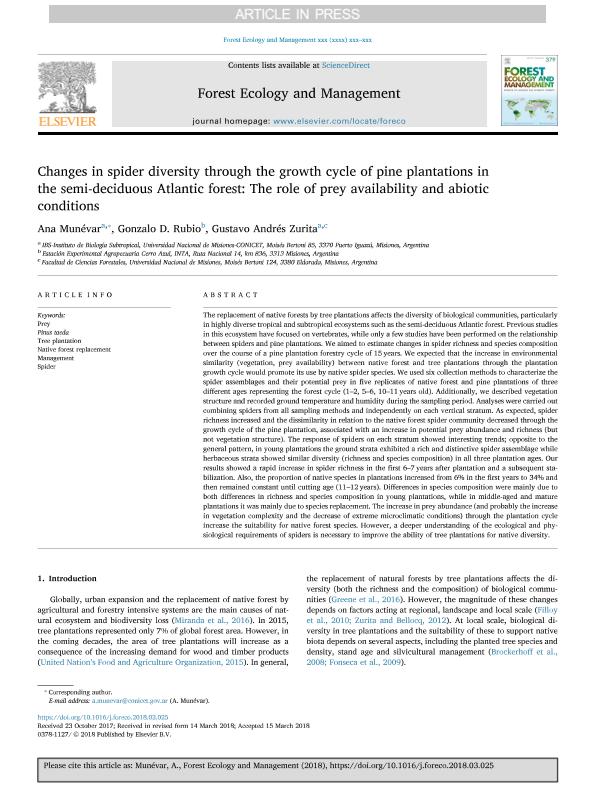Mostrar el registro sencillo del ítem
dc.contributor.author
Munevar Lozano, Ana Katerinne

dc.contributor.author
Rubio, Gonzalo Daniel

dc.contributor.author
Zurita, Gustavo Andres

dc.date.available
2019-10-18T18:27:37Z
dc.date.issued
2018-09
dc.identifier.citation
Munevar Lozano, Ana Katerinne; Rubio, Gonzalo Daniel; Zurita, Gustavo Andres; Changes in spider diversity through the growth cycle of pine plantations in the semi-deciduous Atlantic forest: The role of prey availability and abiotic conditions; Elsevier Science; Forest Ecology and Management; 424; 9-2018; 536-544
dc.identifier.issn
0378-1127
dc.identifier.uri
http://hdl.handle.net/11336/86416
dc.description.abstract
The replacement of native forests by tree plantations affects the diversity of biological communities, particularly in highly diverse tropical and subtropical ecosystems such as the semi-deciduous Atlantic forest. Previous studies in this ecosystem have focused on vertebrates, while only a few studies have been performed on the relationship between spiders and pine plantations. We aimed to estimate changes in spider richness and species composition over the course of a pine plantation forestry cycle of 15 years. We expected that the increase in environmental similarity (vegetation, prey availability) between native forest and tree plantations through the plantation growth cycle would promote its use by native spider species. We used six collection methods to characterize the spider assemblages and their potential prey in five replicates of native forest and pine plantations of three different ages representing the forest cycle (1–2, 5–6, 10–11 years old). Additionally, we described vegetation structure and recorded ground temperature and humidity during the sampling period. Analyses were carried out combining spiders from all sampling methods and independently on each vertical stratum. As expected, spider richness increased and the dissimilarity in relation to the native forest spider community decreased through the growth cycle of the pine plantation, associated with an increase in potential prey abundance and richness (but not vegetation structure). The response of spiders on each stratum showed interesting trends; opposite to the general pattern, in young plantations the ground strata exhibited a rich and distinctive spider assemblage while herbaceous strata showed similar diversity (richness and species composition) in all three plantation ages. Our results showed a rapid increase in spider richness in the first 6–7 years after plantation and a subsequent stabilization. Also, the proportion of native species in plantations increased from 6% in the first years to 34% and then remained constant until cutting age (11–12 years). Differences in species composition were mainly due to both differences in richness and species composition in young plantations, while in middle-aged and mature plantations it was mainly due to species replacement. The increase in prey abundance (and probably the increase in vegetation complexity and the decrease of extreme microclimatic conditions) through the plantation cycle increase the suitability for native forest species. However, a deeper understanding of the ecological and physiological requirements of spiders is necessary to improve the ability of tree plantations for native diversity.
dc.format
application/pdf
dc.language.iso
eng
dc.publisher
Elsevier Science

dc.rights
info:eu-repo/semantics/openAccess
dc.rights.uri
https://creativecommons.org/licenses/by-nc-nd/2.5/ar/
dc.subject
MANAGEMENT
dc.subject
NATIVE FOREST REPLACEMENT
dc.subject
PINUS TAEDA
dc.subject
PREY
dc.subject
SPIDER
dc.subject
TREE PLANTATION
dc.subject.classification
Ecología

dc.subject.classification
Ciencias Biológicas

dc.subject.classification
CIENCIAS NATURALES Y EXACTAS

dc.title
Changes in spider diversity through the growth cycle of pine plantations in the semi-deciduous Atlantic forest: The role of prey availability and abiotic conditions
dc.type
info:eu-repo/semantics/article
dc.type
info:ar-repo/semantics/artículo
dc.type
info:eu-repo/semantics/publishedVersion
dc.date.updated
2019-10-18T15:48:13Z
dc.journal.volume
424
dc.journal.pagination
536-544
dc.journal.pais
Países Bajos

dc.journal.ciudad
Amsterdam
dc.description.fil
Fil: Munevar Lozano, Ana Katerinne. Consejo Nacional de Investigaciones Científicas y Técnicas. Centro Científico Tecnológico Conicet - Nordeste. Instituto de Biología Subtropical. Instituto de Biología Subtropical - Nodo Puerto Iguazú | Universidad Nacional de Misiones. Instituto de Biología Subtropical. Instituto de Biología Subtropical - Nodo Puerto Iguazú; Argentina
dc.description.fil
Fil: Rubio, Gonzalo Daniel. Consejo Nacional de Investigaciones Científicas y Técnicas. Centro Científico Tecnológico Conicet - Nordeste. Instituto de Biología Subtropical. Instituto de Biología Subtropical - Nodo Puerto Iguazú | Universidad Nacional de Misiones. Instituto de Biología Subtropical. Instituto de Biología Subtropical - Nodo Puerto Iguazú; Argentina
dc.description.fil
Fil: Zurita, Gustavo Andres. Consejo Nacional de Investigaciones Científicas y Técnicas. Centro Científico Tecnológico Conicet - Nordeste. Instituto de Biología Subtropical. Instituto de Biología Subtropical - Nodo Puerto Iguazú | Universidad Nacional de Misiones. Instituto de Biología Subtropical. Instituto de Biología Subtropical - Nodo Puerto Iguazú; Argentina
dc.journal.title
Forest Ecology and Management

dc.relation.alternativeid
info:eu-repo/semantics/altIdentifier/doi/http://dx.doi.org/10.1016/j.foreco.2018.03.025
dc.relation.alternativeid
info:eu-repo/semantics/altIdentifier/url/https://www.sciencedirect.com/science/article/pii/S0378112717317814?via%3Dihub
Archivos asociados
